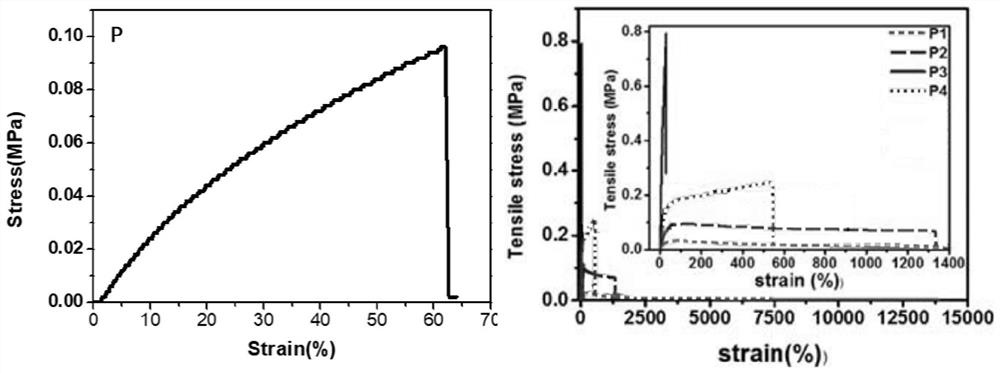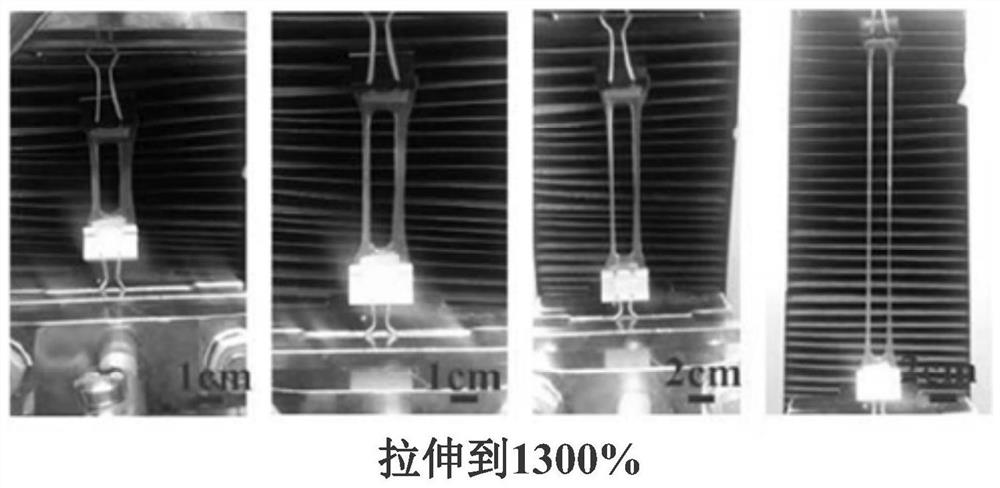Autonomous self-healing elastomer with high tensile properties and its preparation method and application
A tensile performance and self-healing technology, applied in the measurement of the property force of piezoelectric devices, etc., can solve the problems of weak mechanical strength, long repair time, low repair efficiency, etc., and achieve strong mechanical strength and high tensile performance. Effect
- Summary
- Abstract
- Description
- Claims
- Application Information
AI Technical Summary
Problems solved by technology
Method used
Image
Examples
Embodiment 1
[0037] (1) Put 4.6g of double-terminated hydroxyl polydimethylsiloxane (HO-PDMS-OH) in a dry container, stir at 100°C for 1 hour under vacuum to remove moisture, and then cool down to 70°C.
[0038] (2), 0.25g of isophorone diisocyanate (IPDI) and 0.02g of dibutyltin dilaurate (DBTDL) were dissolved in DMAC and added dropwise to the reaction vessel, and stirred at 70°C for 3 hours under nitrogen to synthesize the prepolymer thing.
[0039] (3), 0.06g 4,4'-dithiodianiline and 0.14g 2,2'-bipyridine-4,4'-dicarboxylic acid were dissolved in DMAC and added dropwise to the prepolymer in the reaction vessel In, stirred at 70°C for 3 hours to obtain the reaction product.
[0040] (4) Pour the reacted product into a polytetrafluoroethylene mold, and vacuum-dry at 90° C. for 12 hours to obtain the elastomer P1.
[0041] (5) The molar ratio of silicone resin Psi to weak hydrogen bond compound IP, disulfide bond monomer SS, and strong hydrogen bond compound BNB is 4:8:1:3.
Embodiment 2
[0043] (1) Put 4.60 g of double-terminated hydroxyl polydimethylsiloxane (HO-PDMS-OH) in a dry container, stir at 100°C for 1 hour under vacuum to remove moisture, and then cool down to 70°C.
[0044] (2), 0.25g of isophorone diisocyanate (IPDI) and 0.02g of dibutyltin dilaurate (DBTDL) were dissolved in DMAC and added dropwise to the reaction vessel, and stirred at 70°C for 3 hours under nitrogen to synthesize the prepolymer things.
[0045] (3) Dissolve 0.12g of 4,4'-dithiodianiline and 0.10g of 2,2'-bipyridine-4,4'-dicarboxylic acid in DMAC and add dropwise to the prepolymer in the reaction vessel In, stirred at 70°C for 3 hours to obtain the reaction product.
[0046] (4) Pour the reacted product into a polytetrafluoroethylene mold, and vacuum-dry at 90° C. for 12 hours to obtain the elastomer P2.
[0047] (5) The molar ratio of silicone resin Psi to weak hydrogen bond compound IP, disulfide bond monomer SS, and strong hydrogen bond compound BNB is 2:4:1:1.
Embodiment 3
[0049] (1) Put 4.60 g of double-terminated hydroxyl polydimethylsiloxane (HO-PDMS-OH) in a dry container, stir at 100°C for 1 hour under vacuum to remove moisture, and then cool down to 70°C.
[0050] (2), 0.50g of isophorone diisocyanate (IPDI) and 0.02g of dibutyltin dilaurate (DBTDL) were dissolved in DMAC and added dropwise to the reaction vessel, and stirred at 70°C for 3 hours under nitrogen to synthesize the prepolymer thing.
[0051] (3) Dissolve 0.48g of 4,4'-dithiodianiline and 0.19g of 2,2'-bipyridine-4,4'-dicarboxylic acid in DMAC and add dropwise to the prepolymer in the reaction vessel In, stirred at 70°C for 3 hours to obtain the reaction product.
[0052] (4) Pour the reacted product into a polytetrafluoroethylene mold, and vacuum dry at 90° C. for 12 hours to obtain the elastomer P3.
[0053] (5) The molar ratio of silicone resin PSi to weak hydrogen bond compound IP, disulfide bond monomer SS, and strong hydrogen bond compound BNB is 1:4:2:1.
PUM
| Property | Measurement | Unit |
|---|---|---|
| breaking strength | aaaaa | aaaaa |
| elongation | aaaaa | aaaaa |
Abstract
Description
Claims
Application Information
 Login to View More
Login to View More - R&D
- Intellectual Property
- Life Sciences
- Materials
- Tech Scout
- Unparalleled Data Quality
- Higher Quality Content
- 60% Fewer Hallucinations
Browse by: Latest US Patents, China's latest patents, Technical Efficacy Thesaurus, Application Domain, Technology Topic, Popular Technical Reports.
© 2025 PatSnap. All rights reserved.Legal|Privacy policy|Modern Slavery Act Transparency Statement|Sitemap|About US| Contact US: help@patsnap.com



